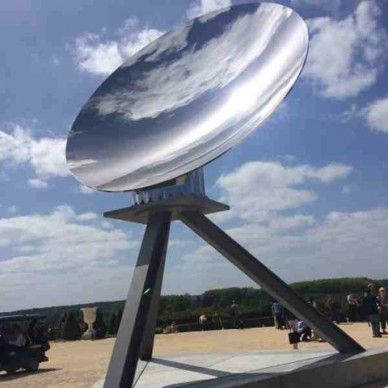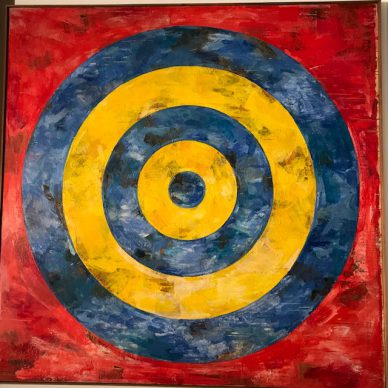This week, I couldn’t meet one person and talk about the suite of five Kapoor installations at Versailles without that person uttering the following words: “Ah! The Queen’s vagina!” I went to the source to understand this vagina story.
I’ve interviewed Anish Kapoor on several occasions. He’s an intelligent man with definite self-control and a sense of humor, but these above words did not fit in with him. Kapoor functions operates through metaphors and concepts, not crude words. He was interviewed by the Journal du Dimanche and allegedly used theseis words, but—and offered no denial he didn’t deny it later on. So lLet’s go toat the source, Versailles, to check out the merit of these gynecological allusions , and, above all, the merit of the works themselves.
You can blame this artist for a lot of things, such as having an elevated business sense that leads him to create a lot of tchotchkes that resemble small versions of his works, but he is a true artist with a rich and complex universe. I wrote a profile of him for Les Échos Weekend on Friday, where I talk about his origins and his contradictions.
Kapoor is a very cultured man who has completely understood the challenges posed by Le Nôtre’s grandiose garden, which uses the sky as an integral part of its design. Two works are particularly pertinent in this context.
One is a kind of gigantic polished-metal spoon reflecting the sky on the chateau’s terrasse. It is as if Kapoor had added a bit of sky to the sky. Infinitely poetic. The other is a 164-foot-long (50-meter-long) cornucopia, surrounded by stones and dirt. A gigantic Korten-steel chaos that in no way resembles a vagina. But a concave space, certainly.
My feelings are much more mixed in the Clairière des Éétoiles (“Clearing of the Sstars”), about thewhere a horrible giant red-plastic cube that contrasts sharply with the chateau’s entire universe. It’s as kitschy as a winemaker’s promotion tent in a French supermarket parking lot. But you can certainly visit the structure and admire the optical illusions created inside and outside the pierced cube.
The attraction at Versailles, at the very end of the perspective, is a vortex, an enormous black abyss of water, moved by a plane propeller, which seems to lead straight to hell. Kapoor likes to play with symbols
But as far as symbols are concerned, I prefer Kapoor’s work in the center of town, in a space I had never seen before, the Jeu de Paume. Before the exhibition opened, a real canon, still present today, fired red balls—or rather, red wax balls—in a corner between two walls. The remains are still present at the foot of the phallic symbol. The whole thing looks like a bloodbath, and it works—, especially given that the painting inspired by David’s Serment du Jeu de Paume is hanging right across from it.
Kapoor is an important artist, with or without Versailles. You have to must go to Versailles, if only to admire the grandiose sky again, as reconfigured by Le Nôtre and a little, also, by Kapoor too.
Support independent news on art.
Your contribution : Make a monthly commitment to support JB Reports or a one off contribution as and when you feel like it. Choose the option that suits you best.
Need to cancel a recurring donation? Please go here.
The donation is considered to be a subscription for a fee set by the donor and for a duration also set by the donor.










